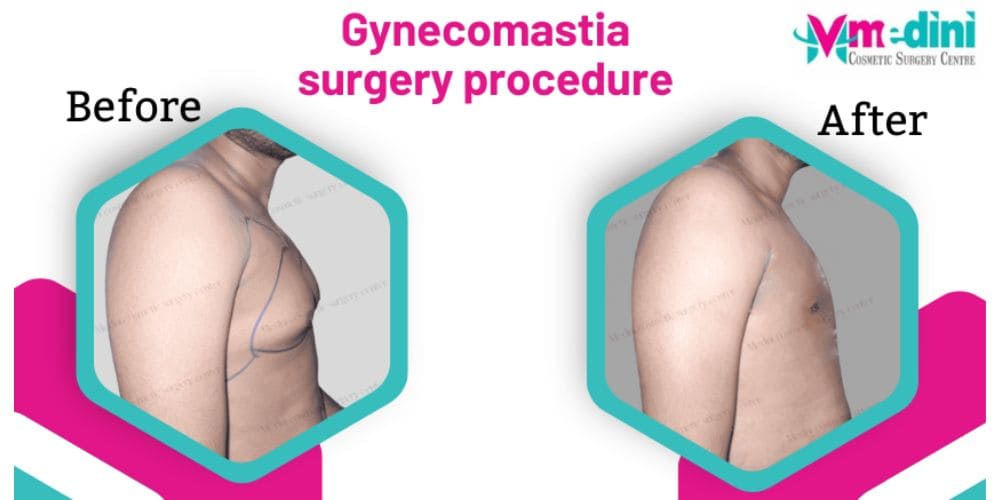


Gynecomastia surgery procedure aims in treating gynecomastia condition which is characterized by the enlargement of male breast tissue. Gynecomastia often causes physical discomfort in the chest region and hence causes psychological distress to the individual.
It’s important to recognize that gynecomastia is not simply a result of excess fat accumulation in the chest area, but rather a combination of glandular tissue proliferation and fatty deposits. This understanding is crucial because the treatment approach, particularly surgical intervention, varies depending on the underlying cause of gynecomastia.
While lifestyle modifications, hormone therapy, and medications may be effective in some cases, they often fail to provide satisfactory results for individuals with significant breast tissue enlargement. Gynecomastia surgery procedure also known as male breast reduction surgery, emerges as a viable solution for those seeking a more permanent and transformative outcome. By addressing the root cause of gynecomastia through surgical intervention, patients can achieve a flatter and more masculine chest contour, ultimately enhancing their self-confidence and quality of life.

Gynecomastia surgery procedure encompasses various techniques tailored to the specific needs of each patient. One commonly employed method is liposuction, which targets excess fat deposits in the chest area. During liposuction, a small incision is made, and a thin tube called a cannula is inserted to suction out the fat. This technique is particularly suitable for individuals with gynecomastia primarily caused by adipose tissue accumulation.

(MBBS, MS, MCh – Plastic Surgery with 22 Years Experience)
In cases where gynecomastia is primarily due to glandular tissue proliferation, surgical excision becomes necessary. This technique involves making discreet incisions around the areola or in the natural creases of the chest to access and remove the excess glandular tissue. By directly addressing the glandular component of gynecomastia, surgeons can achieve a more sculpted and masculine chest appearance.
Gynecomastia surgery procedure is typically performed under general anesthesia to ensure patient comfort and safety throughout the procedure. The duration of surgery varies depending on the complexity of the case and the techniques employed. On average, the procedure can last anywhere from one to three hours, during which the surgeon meticulously reshapes the chest contours to achieve optimal results.
One of the most significant benefits of gynecomastia surgery procedure is the physical transformation it offers. By reducing the size of the breasts and creating a more masculine chest contour, patients experience a tangible improvement in their appearance. This enhancement not only boosts self-esteem but also allows individuals to feel more comfortable and confident in their own skin.

Beyond the physical changes, gynecomastia surgery has profound psychological benefits. Many men who undergo the procedure report a significant improvement in their self-confidence and overall well-being. By alleviating the social stigma and emotional distress associated with gynecomastia, patients can enjoy a newfound sense of freedom and empowerment in various aspects of their lives.
While gynecomastia surgery procedure is generally safe, it’s essential for patients to be aware of the potential risks and complications associated with the procedure. These may include infection, bleeding, changes in nipple sensation, asymmetry, and scarring. However, by choosing a qualified and experienced plastic surgeon and adhering to post-operative care instructions, these risks can be minimized.
Before undergoing gynecomastia surgery procedure, patients undergo a thorough preoperative evaluation to assess their candidacy for the procedure. This evaluation includes a comprehensive medical history review, physical examination, and discussion of expectations and goals. Ideal candidates for gynecomastia surgery procedure are generally in good overall health, have realistic expectations, and are committed to following post-operative guidelines for optimal results.
Following gynecomastia surgery procedure, patients are provided with detailed post-operative instructions to facilitate a smooth recovery process. This may include wearing compression garments to minimize swelling and support the chest tissues, avoiding strenuous activities for a specified period, and taking prescribed medications to manage discomfort and prevent infection. Regular follow-up appointments with the surgeon are scheduled to monitor progress and address any concerns that may arise during the healing phase.
The recovery timeline after gynecomastia surgery procedure varies from patient to patient but typically follows a similar trajectory. In the initial days and weeks post-surgery, patients may experience some degree of swelling, bruising, and discomfort, which gradually subsides over time. Most individuals can resume light activities within a week or two, while full recovery and final results may take several months to become apparent.
In conclusion, gynecomastia surgery procedure offers a transformative solution for men struggling with the physical and emotional challenges of enlarged breast tissue. By understanding the intricacies of the procedure, its benefits, and potential risks, individuals can make informed decisions about their treatment options. If gynecomastia is impacting your quality of life, consulting with a board-certified plastic surgeon can help you explore whether surgery is the right choice for you. With advancements in surgical techniques and dedicated post-operative care, gynecomastia surgery enables individuals to regain confidence and embrace a more positive self-image.
Medini Cosmetic Surgery © 2021 All rights reserved – Designed & Developed By Ravi Varma
*By filling the form you are giving us the consent to receive emails from us regarding all the updates.
